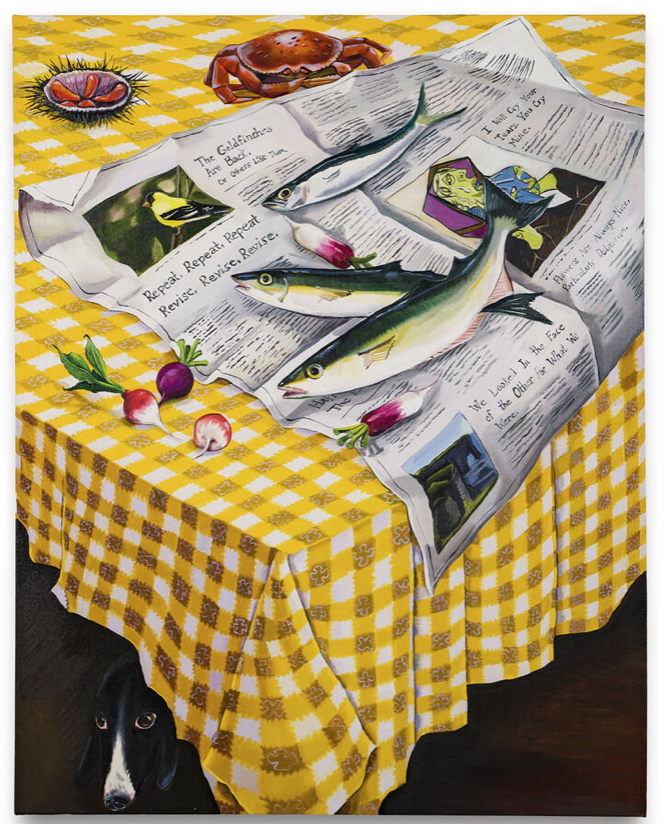After the tendency of still life paintings in an abstract direction, there a tons of contemporary examples, where artists try to interpret the still life theme for themselves. In painted artworks nearly everything is possible and therefore it became quite popular to not show the still life scenario in a realistic way. The next few examples are some recent works, which have quite different styles and most of them are obviously influenced by the 20th century.
The first example is made by Hilary Pecis, who works and lives in Los Angeles. Her style is quite colorful and also profit from a flat optic. The light in Pecis’ paintings bounces across the canvas as saturated color connects objects through pattern and manipulated perspectives. Her technique explores line, font, perspective, and color as stacks of books and vases of flowers sit on surfaces of rhythmic pattern. The art she creates includes many sites and scenes from her personal cache of photographs. These photographs focus on certain details, which help to portray the feeling of a captured moment. Her vibrant artwork found its inspiration in art-historical references, and with art itself. As a fun fact in her painted rooms there are often figurative and abstract canvases hanging which are recreated by her fellow artist colleagues. Moreover in her artworks there is a certain vibe domaining which makes the still life really dynamic and realistic.
Another example, which shows an even more abstract approach than the first example. It is massively inspired by the cubism and its philosophy of flat shapes and changing the thought of perspective. The artist Holly Coulis is fascinated by the stillness itself and she claims that we search for movement in every genres of paintings, even if they are abstract. But the still life has no movement before and after it was painted. It would be still as long as something disturbs the calmness. For her this still compositions are having an intimate personality. Coulis still lifes are showing an unseen character’s private things. Like solidly colored fruits, vases, knives, cigarettes and cats dancing around Coulis canvases, cheerfully bumping against one another. She crates forms in varied, bold hues, giving them radiant, vibrational auras. Pop art, Cubism, and abstraction inform the flat color, geometry, “off perspective,” and playfulness in Coulis’s paintings.
The next example also plays around with perspective and realistic optics. The artist Nicole Dryer deals with the presentation from branded objects in a pop art style. Her work is influenced by previous artworks from artist like Andy Warhol and more recently Katherine Bernhardt. Dryer is interested in the people’s reaction towards products and if they trigger an intense emotional response. This could be a reaction such as nostalgia, commitment or hope. Therefore consumerism is a major topic for her paintings. Even though Pop art is the most direct influence, the artist also profits from much older aesthetic tradition from Dutch still life paintings.
The last example is even more inspired by the classic tabletop composition. The artist is called Nikki Maloof and plays a lot with the presentation of set tables. The motives are often dead and alive animals like fish, oysters and lobsters. The food is combined with colorful table decoration and often shows a scenario of action, like a cat that is looking to the food. As dynamic and vibrant the paintings are, as much contrary emotions of anxiety and fear are transported through the picture. The artist is inspired by the “lush textures,” “hyperdramatic arrangements,” and “symbolism” of the Dutch vanitas tradition. She’s particularly drawn to the moments in the 17th-century canvases where it becomes clear that “the artists drifted into fantasy to achieve the drama they were looking for.” The closer she looks at these paintings, she said, the more they begin to “feel like stages for operas or plays about the everyday.”
Quellen:
https://www.artsy.net/article/artsy-editorial-17-contemporary-artists-reimagining-life











